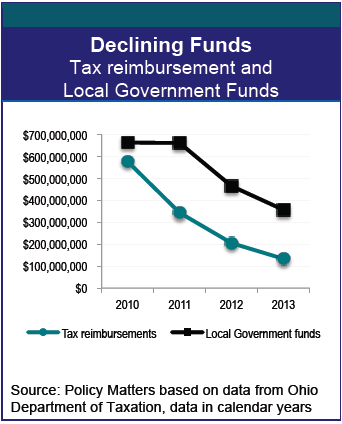
Auglaize County
October 31, 2012
Auglaize County
October 31, 2012
Impact of Ohio’s 2012-13 state budget (HB 153)
 Ohio’s budget for 2012 and 2013 cut local government aid by a billion dollars. This means cuts in services we depend on, from road repair and emergency services to crossing guards, senior transportation and child protective services. What are the implications for Auglaize County?
Ohio’s budget for 2012 and 2013 cut local government aid by a billion dollars. This means cuts in services we depend on, from road repair and emergency services to crossing guards, senior transportation and child protective services. What are the implications for Auglaize County?
The state cut the Local Government Fund to the county, forcing Auglaize County to make cuts to jurisdictions within the county. The state also cut direct funding to municipalities, and slashed reimbursements for taxes it had eliminated, taxes that businesses and utilities had paid to local governments. School districts and the public library fund were also cut. Losses in calendar years 2012 and 2013, compared to 2010 and 2011, include, among others:
- Public Library Fund.................. -$92 thousand
- Schools................................... -$6.5 million
- County operations.................... -$1.2 million
- Minster City............................ -$207 thousand
- New Bremen City..................... -$115 thousand
- St. Mary’s City......................... -$354 thousand
- Wapakoneta City..................... -$351 thousand
Loss to health and human service levies
- County mental health............... -$306.4 thousand
- County health services.............. -$ 80.8 thousand
- County seniors’ services............ -$70.8 thousand
- Parks..................................... -$25.9 thousand
Notes and quotes
 “If people want cuts on the state level, you have got to give up something. What’s it going to be? Get rid of the sheriff’s deputies on the road? [Let out] inmates, people unsafe to the county? Pay more taxes to not give up anything?” - Janet Schuler, Auglaize County Auditor
“If people want cuts on the state level, you have got to give up something. What’s it going to be? Get rid of the sheriff’s deputies on the road? [Let out] inmates, people unsafe to the county? Pay more taxes to not give up anything?” - Janet Schuler, Auglaize County Auditor
Mayor Rolston proposed that Uniopolis turn off its street lights and that it disincorporate “after more than a century in existence.” From Semuels, Alana. “State budget cuts hit small-town Ohio.” Los Angeles Times. March 4, 2012. http://tinyurl.com/978xlsc.
The village of Uniopolis is now without a police department and citizens are worried about safety, especially when it gets dark. From “Uniopolis councilors move toward dissolving village.” The Lima News. March 5, 2012. http://tinyurl.com/9hxfjyo.
“We're not out of money now. We're paying bills fine now. But long-term, this is not going to work.” -Uniopolis Councilor Greg Ritchie, Auglaize County. From “Uniopolis councilors move toward dissolving village.” The Lima News. March 5, 2012. http://tinyurl.com/9hxfjyo.
"We've decided that with the budget cuts, we just can't do it anymore. About the only thing that can save it now is an act of God." – William Rolston, Mayor of Uniopolis. From “Uniopolis councilors move toward dissolving village.” The Lima News. March 5, 2012. http://tinyurl.com/9hxfjyo.
NOTES: The current state budget cuts the Local Government Fund to counties, municipalities and townships by 25 percent in the first year and by 50 percent in the second year. This 77-year old state revenue sharing program has, for generations, been essential to helping Ohio communities fund schools, provide services, and lift people out of poverty. The current state budget also phases out most of the tangible personal property tax and public utility property tax reimbursements, which were promised to local governments when the state cut taxes in recent years. These are not the only losses to local governments because of this budget. There are others in specific programs. Here we detail some of the bigger shifts. Change in revenues shown here include:
- Local Government Fund "County Undivided Fund," which counties share with their cities, townships and villages. We show how much less money the counties are receiving under the current 2-year state budget (for 2012 and 2013) compared to the two years under the prior state budget (which was for 2010 and 2011). Here the funds are shown on a calendar year basis because that is how the tax department forecasts and records their distribution to local governments, and it is how local governments budget (The state budget is based on the fiscal year, July 1 through June 30.)
- Local Government “Municipal Direct” allocation from the Local Government Fund that the state gives directly to localities. This is also shown in terms of funding provided in the calendar years 2012 and 2013 compared to 2010 and 2011;
- Property tax reimbursements promised to local governments during tax reductions enacted earlier in the decade. The loss of funding in calendar years 2012 and 2013 is compared to the level of funding provided in 2010 and 2011.
The figures for changes in funding levels are based on data provided by and spreadsheets online at the Ohio Department of Taxation for local government funds and tax reimbursement distributions.
Photo Gallery
1 of 22